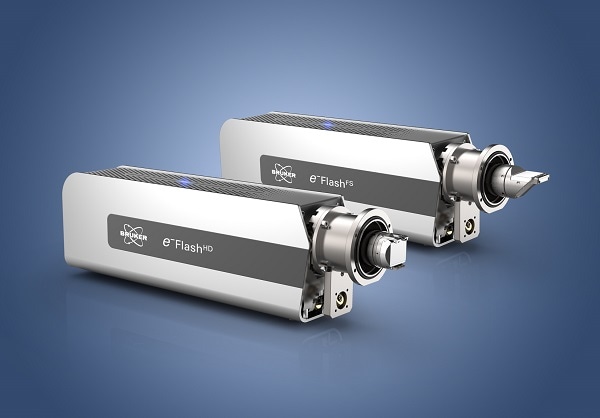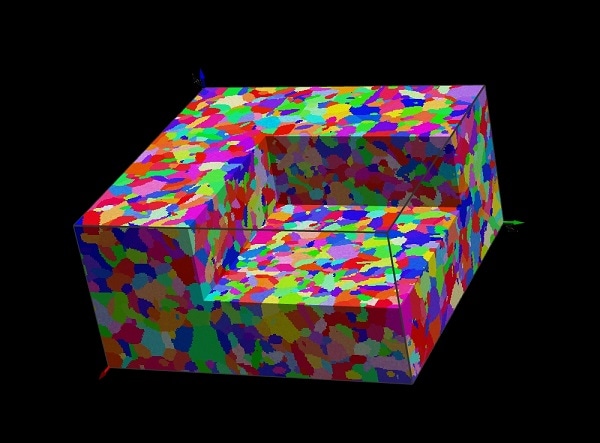At the Microscopy & Microanalysis 2016 Meeting, Bruker today introduces the e-FlashFS and e-FlashHD, two models of a new generation of detectors for electron backscatter diffraction (EBSD) analysis on scanning electron microscopes (SEM), andESPRIT™ QUBE, a new software package for advanced post-processing and visualization of 3D EBSD/EDS data cubes.

With the fast and sensitive e-FlashFS and the high definition e-FlashHD Bruker now offers two complementary detectors to optimally cover all EBSD applications from everyday characterization of minerals and alloys to advanced analysis of nano- and functional materials.
Due to an increase in sensitivity by a factor of three compared to its predecessor e-Flash1000, the new e-FlashFS will significantly expand the range of application fields where high- speed EBSD can be used. The combination of improved sensitivity and high speed makes the e-FlashFS the EBSD detector of choice for low-kV applications, as well as for dynamic experiments such as in-situ heating or tensile testing. When equipped with the unique OPTIMUS™ detector head for transmission Kikuchi diffraction (TKD), the e-FlashFS provides orientation maps with spatial resolution as good as 2 nm and high contrast dark field/ bright field images with resolution of 1 nm or better, all within minutes or even seconds, enabling applications in many areas such as the semiconductor industry that were only accessible by transmission electron microscopy (TEM) until now.

The new e-FlashHD detector features a CCD camera resolution of 1,600 x 1,200 pixels and state-of-the-art camera optics for minimized image distortions, enabling high definition Kikuchi patterns that display the finest details. Due to improvements to the cooling system, the CCD’s dark current is reduced by a factor of four compared to the previous generation e-FlashHR, resulting in significantly enhanced signal-to-noise ratios and thus even better pattern quality. These advancements make the e-FlashHD a very powerful tool for residual strain analysis, ultra-accurate phase identification, or the analysis of pseudo-symmetry in crystalline structures.
The new ESPRIT QUBE software provides extensive and powerful tools for 3D visualization and post-processing of data sets acquired with electron backscatter diffraction systems (EBSD) and/or energy-dispersive X-ray spectrometers (EDS). Whether 3D data sets are generated automatically in dedicated FIB/SEM instruments, or by using conventional metallography techniques and standard SEM, ESPRIT QUBE enables true 3D data representation and analysis. By providing grain, inclusion and porosity metrics, or by providing the ability to analyze the density of structural defects such as geometrically necessary dislocations (GNDs), ESPRIT QUBE helps scientists gain a profound understanding of advanced materials and their properties. A multitude of options for data filtering, sub-setting, simulation and visualization provide advanced 3D insights into the deformation mechanisms of materials, and enable crystal plasticity studies. ESPRIT QUBE complements QUANTAX™ EBSD and EDS systems with even more efficient investigation and interpretation of simultaneously acquired EBSD/EDS data.
Our new generation of EBSD detectors once again pushes the boundaries in ‘Hough based’ EBSD applications and in high-speed TKD analysis, as well as in residual strain analysis, known as HR-EBSD. The significant improvements in detector sensitivity, pattern quality, effective spatial resolution, and speed reflect Bruker’s commitment to continuously advance high-performance solutions for scientific research and industry. With its state-of-the-art quaternion based approach, ESPRIT QUBE is the most advanced analytical software for processing and visualizing 3D EBSD and EDS data sets. ESPRIT QUBE is the result of an ongoing successful collaboration between Bruker and the Max Plank Institute for Iron Research in Düsseldorf, Germany. Its development was driven by the idea to provide easy access to advanced post-processing capabilities of 3D data cubes for all researchers – from entry to expert level.
Dr. Daniel Goran, Product Manager EBSD at Bruker’s Nano Analytics division